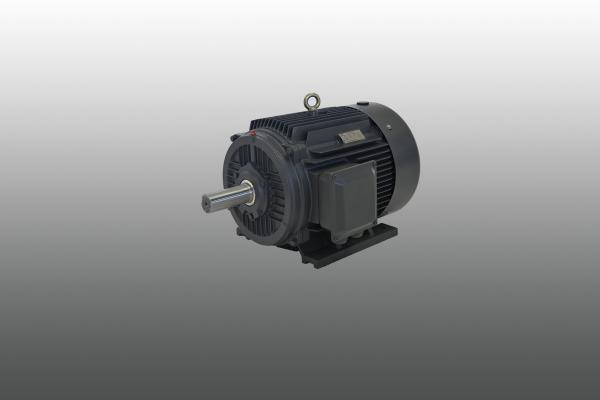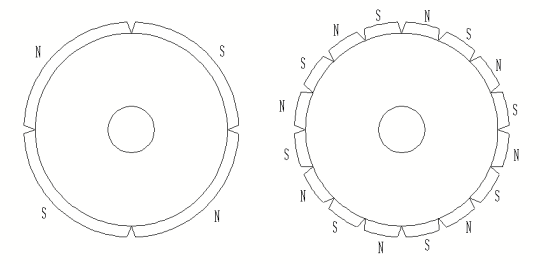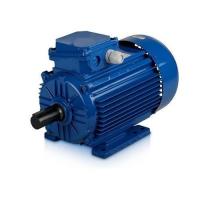The defining feature of PMACMs – the permanent magnets within their
rotor – are acted upon by the rotating magnetic field (RMF) of the
stator windings, and are repelled into rotational motion. This is a
deviation from other rotors, where the magnetic force must be
induced or generated in the rotor housing, requiring more current.
This means that PMACMs are generally more efficient than induction
motors, as the rotor’s magnetic field is permanent and does not
need a source of power to be used for its generation. This also
means that they require a variable frequency drive (VFD, or PM
drive) to operate, which is a control system that smooths out the
torque produced by these motors. By switching the current on and
off to the stator windings at certain stages of rotor rotation, the
PM drive simultaneously controls torque and current and uses this
data to calculate rotor position, and therefore the speed of the
shaft output. They are synchronous machines, as their rotational
speed matches the speed of the RMF. These machines are relatively
new and are still being optimized, so the specific operation of any
one PMACM is, for now, essentially unique to each design.
EMF and Torque Equation
In a synchronous machine, the average EMF induced per phase is
called dynamic induces EMF in a synchronous motor, the flux cut by
each conductor per revolution is Pϕ Weber
Then the time taken to complete one revolution is 60/N sec
The average EMF induced per conductor can be calculated by using
( PϕN / 60 ) x Zph = ( PϕN / 60 ) x 2Tph
Where Tph = Zph / 2
Therefore, the average EMF per phase is,
= 4 x ϕ x Tph x PN/120 = 4ϕfTph
Where Tph = no. Of turns connected in series per phase
ϕ = flux/pole in Weber
P= no. Of poles
F= frequency in Hz
Zph= no. Of conductors connected in series per phase. = Zph/3
The EMF equation depends on the coils and the conductors on the
stator. For this motor, the distribution factor Kd and pitch factor
Kp are also considered.
Hence, E = 4 x ϕ x f x Tph xKd x Kp
The torque equation of a permanent magnet synchronous motor is
given as,
T = (3 x Eph x Iph x sinβ) / ωm
Why choose permanent magnet AC motors?
Permanent magnet AC (PMAC) motors offer several advantages over
other types of motors, including:
High Efficiency: PMAC motors are highly efficient due to the
absence of rotor copper losses and reduced winding losses. They can
achieve efficiencies of up to 97%, resulting in significant energy
savings.
High Power Density: PMAC motors have a higher power density
compared to other motor types, which means they can produce more
power per unit of size and weight. This makes them ideal for
applications where space is limited.
High Torque Density: PMAC motors have a high torque density, which
means they can produce more torque per unit of size and weight.
This makes them ideal for applications where high torque is
required.
Reduced Maintenance: Since PMAC motors have no brushes, they
require less maintenance and have a longer lifespan than other
motor types.
Improved Control: PMAC motors have better speed and torque control
compared to other motor types, making them ideal for applications
where precise control is required.
Environmentally Friendly: PMAC motors are more environmentally
friendly than other motor types since they use rare earth metals,
which are easier to recycle and produce less waste compared to
other motor types.
Overall, the advantages of PMAC motors make them an excellent
choice for a wide range of applications, including electric
vehicles, industrial machinery, and renewable energy systems.
Permanent magnet synchronous motors with internal magnets: Maximum
energy efficiency
The permanent magnet synchronous motor with internal magnets
(IPMSM) is the ideal motor for traction applications where the
maximum torque does not occur at maximum speed. This type of motor
is used in applications that require high dynamics and overload
capacity. And it is also the perfect choice if you want to operate
fans or pumps in the IE4 and IE5 range. The high purchase costs are
usually recouped through energy savings over the run time, provided
that you operate it with the right variable frequency drive.
Our motor-mounted variable frequency drives use an integrated
control strategy based on MTPA (Maximum Torque per Ampere). This
allows you to operate your permanent magnet synchronous motors with
maximum energy efficiency. The overload of 200 %, the excellent
starting torque, and the extended speed control range also allow
you to fully exploit the motor rating. For fast recovery of costs
and the most efficient control processes.
Permanent magnet synchronous motors with external magnets for
classic servo applications
Permanent magnet synchronous motors with external magnets (SPMSM)
are ideal motors when you need high overloads and rapid
acceleration, for example in classic servo applications. The
elongated design also results in low mass inertia and can be
optimally installed. However, one disadvantage of the system
consisting of SPMSM and variable frequency drive is the costs
associated with it, as expensive plug technology and high-quality
encoders are often used.
Applications:
Permanent magnet synchronous motors can be combined with frequency
converters to form the best open-loop step-less speed control
system, which has been widely used for speed control transmission
equipment in petrochemical, chemical fiber, textile, machinery,
electronics, glass, rubber, packaging, printing, paper making,
printing and dyeing, metallurgy and other industries.
Self-sensing versus closed-loop operation
Recent advances in drive technology allow standard ac drives to
“self-detect” and track the motor magnet position. A closed-loop
system typically uses the z-pulse channel to optimize performance.
Through certain routines, the drive knows the exact position of the
motor magnet by tracking the A/B channels and correcting for errors
with the z-channel. Knowing the exact position of the magnet allows
for optimum torque production resulting in optimum efficiency.
Flux weakening/intensifying of PM motors
Flux in a permanent magnet motor is generated by the magnets. The
flux field follows a certain path, which can be boosted or opposed.
Boosting or intensifying the flux field will allow the motor to
temporarily increase torque production. Opposing the flux field
will negate the existing magnet field of the motor. The reduced
magnet field will limit torque production, but reduce the back-emf
voltage. The reduced back-emf voltage frees up the voltage to push
the motor to operate at higher output speeds. Both types of
operation require additional motor current. The direction of the
motor current across the d-axis, provided by the motor controller,
determines the desired effect.
Advantages of PMAC Motors
The primary advantage of PMAC motors lies in their efficiency. They
operate without the need for any electrical current to generate a
magnetic field. As a result, they experience fewer electrical
losses commonly found in traditional AC synchronous motors. This
enhanced efficiency leads to reduced heat generation, ultimately
improving the motor's lifespan and reliability.
In addition to their efficiency, PMACs offer several other
benefits. They boast a higher torque capacity and achieve better
utilization of torque, facilitating faster acceleration.
Furthermore, their compact design, high torque density, and
lightweight construction allow them to be installed in smaller
spaces without compromising performance output. Moreover, PMAC
motors excel in maintaining a higher continuous torque across a
wide range of speeds, benefiting from reduced rotor inertia and
enhanced dynamic performance under load.
PMAC motors are able to achieve high efficiency at low speeds,
making them suitable for applications that require low-speed
operation, such as fans and pumps.










